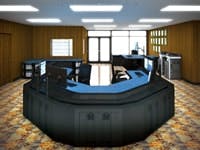With a capacity of 12 million gal per day, the Benicia Water Treatment Plant (WTP) is a 24/7 regulated industrial surface water treatment complex that produces drinking water for 28,000 citizens, a vibrant industrial base and an extensive commercial community in Benicia, Calif.
Recently, in order to add security functions to the main operator control console (OCC), the city received approval to install new consoles in the plant’s operations center.
Designing and installing the new consoles using existing infrastructure, however, was no small feat. Cabinetry housing the previous technology, affectionately referred to as “Big Blue,” included all of the dials and gauges used to run the plant and had to be removed from the control room. Doing so left two large holes in the concrete floor where power and data feeds connected to the main controls, located one floor below.
Because the floor itself was constructed of thick concrete, it could not easily be re-drilled or troughed. The new main console would need to utilize existing connection points.
“We selected Winsted to produce our console because of its ability to build a unique piece of furniture that wrapped over specific access ports for electrical and communication cabling from the lower level of the facility,” said Leo Larkin, water treatment plant supervisor for the city of Benicia. “The cabling is ported through a concrete floor, so specific locations were necessary for the curved footprint of the OCC.”
The main OCC primarily is a Sight-Line console with a curved U-shape design that allows the necessary electrical and communication connections to be made using existing infrastructure. It is considered a single-person workstation for the shift operator, but could easily accommodate three to four operators.
The OCC features a total of six monitors mounted to the console using the Versa-Trak monitor mounting system, which offers an array of flexible adjustment options to suit the needs of virtually any operator. There are two 17-in. SCADA monitors used to monitor the water treatment process; two 17-in. monitors dedicated to security surveillance for onsite and remote location monitoring; and two 14-in. monitors—one for the security alarm software and the other for weather monitoring and data collection. All of the monitors are connected to CPUs and controlled using a mouse or keyboard.
A turret mounted atop the console at one end now houses the controls that would have previously been found in “Big Blue.” This includes two proportional-integral-derivative controllers linked to the programmable logic controller for the WTP—one controls raw water flow and the other controls water flow when filters are backwashed. The turret also contains a start/stop controller for the large water pump and an emergency WTP shutdown button.
At the other end of the OCC is the SCADA work-
station, which incorporates an ergonomically designed Ascend sit/stand console featuring electric-lift legs, which enables operators to quickly and easily adjust the work surface height from 29 to 45 in. with the push of a button.
Additional Consoles
In addition to the main OCC, the city worked with Winsted to design three more consoles for the WTP control room. Two of these workstations are for relief operators who provide support to routine operations, such as calibrating and maintaining instruments and analyzers. These were created using the Insight console, which is designed with a compact profile to maximize space while still allowing ample desktop workspace.
The final console is for an administrative position in the control room. This workstation was designed using the Slat-Wall console, which features a 15-in.-tall slat-wall for mounting monitors, shelves and other accessories.
Each console provides easy-access CPU storage in the base cabinets, as well as plenty of binder storage and a number of drawers for storing files and personal belongings.
In addition to space constraints and the challenge of aligning the new OCC with existing electrical and communications connections, a great deal of thought went into the layout of the additional workstation consoles. Sight-Lines to and from the windows into the plant, two supervisors’ offices and chemical room all were critical to the final positioning of each workstation.
Some other features of Benicia’s water treatment control room include the “industrial chic” custom work surfaces and end panels made of Winsted’s Marmoleum material. This material is made of natural and sustainable raw materials, which emit no volatile organic compounds and are completely biodegradable. They also are impact, chemical and heat resistant for long lasting durability. Also, the city requested that its logo be placed on the front panel of the main OCC so it is visible as visitors enter the facility.
The city of Benicia was able to utilize existing infrastructure to create a completely new control room featuring modern technology that will allow operators to work efficiently and comfortably for many years.
Download: Here


